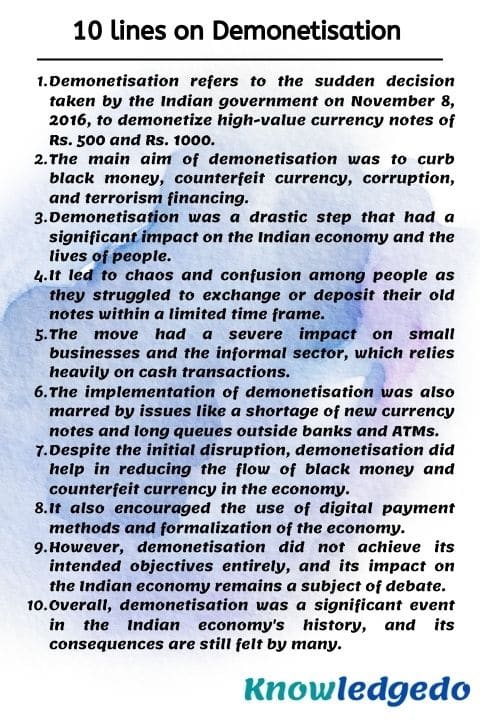Today, we are sharing 10 lines on Demonetisation in English. This article can help students who are looking for information about 10 lines on Demonetisation. This Lines is very simple and easy to remember. The level of these Lines is moderate so any student can write on this topic.
This article is generally useful for class 1,class 2,class 3,class 4,class 5,class 6,class 7,class 8,class 9,class 10,class 11,class 12
10 lines on Demonetisation
1) Demonetisation refers to the sudden decision taken by the Indian government on November 8, 2016, to demonetize high-value currency notes of Rs. 500 and Rs. 1000.
2) The main aim of demonetisation was to curb black money, counterfeit currency, corruption, and terrorism financing.
3) Demonetisation was a drastic step that had a significant impact on the Indian economy and the lives of people.
4) It led to chaos and confusion among people as they struggled to exchange or deposit their old notes within a limited time frame.
5) The move had a severe impact on small businesses and the informal sector, which relies heavily on cash transactions.
6) The implementation of demonetisation was also marred by issues like a shortage of new currency notes and long queues outside banks and ATMs.
7) Despite the initial disruption, demonetisation did help in reducing the flow of black money and counterfeit currency in the economy.
8) It also encouraged the use of digital payment methods and the formalization of the economy.
9) However, demonetisation did not achieve its intended objectives entirely, and its impact on the Indian economy remains a subject of debate.
10) Overall, demonetisation was a significant event in the Indian economy’s history, and its consequences are still felt by many.

5 lines on Demonetisation
1) Demonetisation refers to the decision taken by the Indian government on November 8, 2016, to withdraw high-value currency notes of Rs. 500 and Rs. 1000 from circulation.
2) The move was aimed at curbing black money, corruption, counterfeit currency, and terrorism financing.
3) Demonetisation led to chaos and confusion among the public, with long queues outside banks and ATMs as people rushed to exchange or deposit their old notes.
4) The move had both positive and negative impacts on the Indian economy, with some sectors suffering while others benefited.
5) Despite its mixed results, demonetisation remains a significant event in the Indian economy’s history, with long-lasting consequences.
FAQ
Answer: Demonetisation in India refers to the government’s decision to withdraw high-value currency notes of Rs. 500 and Rs. 1000 from circulation in November 2016.
Answer: The primary objective of demonetisation was to curb black money, corruption, counterfeit currency, and terrorism financing by reducing the amount of cash circulating in the economy.
Answer: Demonetisation had both positive and negative impacts on the Indian economy. While it led to a temporary slowdown in economic activity, it also encouraged the use of digital payment methods and the formalization of the economy. It also helped in reducing the flow of black money and counterfeit currency.
Answer: The effectiveness of demonetisation in achieving its intended objectives remains a subject of debate. While it did lead to a reduction in the flow of black money and counterfeit currency, the overall impact on corruption and terrorism financing is still uncertain. Additionally, it caused significant disruption to the economy, especially the informal sector.
